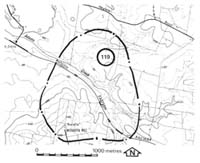119. Nyora - Heath Hill Fault
|
This information has been developed from one or more of these publications:
|
Location: | Nyora - 810590 to 825567. Four kilometres north-west of Nyora. | |
Access: | McDonalds Track, Heylens Road. | |
Ownership: | Crown Land and some private land | |
Geology: | The site includes the trace of the Heath Hill Fault. Baxter Formation sediments are exposed on the downthrown (western) and upthrown (eastern) blocks including one outlier in the railway cutting 1.5 kilometres west of Nyora. In the valley of a small creek south of the railway lines, Mesozoic sediments are seen to underlie the Baxter Formation sediments. West of the fault scarp, the Baxter Formation is largely buried by Cranbourne Sand and outcrops are confined to inliers at the ridge crests. | |
Significance: | Regional. The site displays the physiographic expression of the Heath Hill Fault and allows assessment to be made of the displacement by comparing the elevations of the Baxter Formation. | |
Management: | Class 3. The significance of features of interest at the site will be unlikely to be reduced by changes in land use. | |



